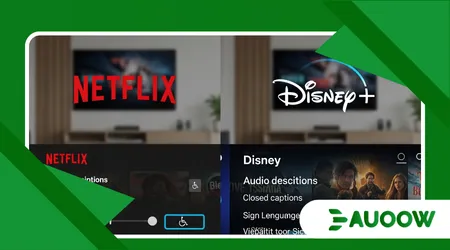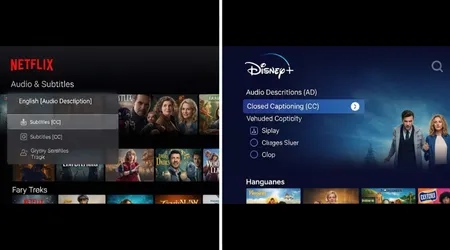The Rise of Accessibility in Streaming Services: Netflix vs Disney+

The Rise of Accessibility in Streaming Services marks a pivotal shift in digital entertainment, evolving from regulatory compliance to a fundamental competitive strategy.
In 2025, two giants, Netflix and Disney+, are engaged in a fierce battle to provide the most inclusive viewing experience globally. This competition directly impacts millions of users with sensory disabilities.
This column analyzes their strategies, dissecting which platform currently offers the most robust and user-friendly experience for people with disabilities.
This technological and ethical arms race acknowledges the immense, often overlooked, market segment of viewers with vision and hearing loss.
Streamers recognize that true market dominance means reaching every viewer, not just those without access needs.
The platform that simplifies features like Audio Description and closed captions will undoubtedly capture more subscribers.
Why is Accessibility Now a Core Business Strategy for Streamers?
Accessibility has cemented its position as a core business driver, moving far beyond legal mandates.
The global market size of people with disabilities is staggering, making this an undeniable economic opportunity. Ignoring this segment is now seen as poor business strategy.
The shift is evident in user data. A key finding from a recent industry report highlighted that 71% of viewers cited “Accessibility/search of desired content” as an important factor when choosing a streaming service.
This statistic proves that ease of use for all features, including accessibility options, directly influences subscription decisions.
++ Why Accessible UX Design Is Not Optional Anymore
How Does the European Accessibility Act (EAA) Drive Change?
The recent enactment of the European Accessibility Act (EAA) in June 2025 has forced digital service providers to accelerate their accessibility efforts globally.
This legislation mandates simplified discovery for titles with subtitles or Audio Description, and requires accessible subscription management.
The EAA’s influence extends far beyond the EU, establishing a high international standard that all major players must meet.
Companies must adapt or risk losing access to one of the world’s most lucrative digital markets.
This regulatory pressure provides an excellent, non-market-based incentive for innovation. Compliance, in this case, forces a better product for everyone.
Also read: How to Plan Grocery Trips with a Wheelchair: A Realistic Guide
What is the Economic Value of the Disability Market?
The economic value of including the disability community is immense. Beyond the purchasing power of disabled consumers, there is the positive brand halo effect.
Companies perceived as inclusive benefit from higher customer loyalty and positive social media commentary, which reduces overall marketing costs.
As a result, accessibility features are now prominently featured in marketing campaigns, signaling to this powerful demographic that they are valued. In a market where subscriber churn is a constant threat, loyalty through inclusion is priceless.

How Does Netflix Lead the Race in Audio Description and Subtitling?
Netflix has long been the pioneer in standardizing advanced accessibility features, setting the benchmark for the entire industry.
Their approach is characterized by aggressive internal investment and clear user interface design. They consistently lead The Rise of Accessibility in Streaming Services.
Netflix was one of the first major streamers to heavily invest in Audio Description (AD) for its original content.
Their library of AD-enabled titles is often cited as the largest, providing a seamless, high-quality experience for viewers who are blind or have low vision. The company treats AD as a post-production necessity, not an optional extra.
Reas more: How AR Navigation Apps Are Helping Disabled Travelers Explore Cities
What is Netflix’s Advantage in Customization?
Netflix excels in providing deep customization options for subtitles and closed captions. Users can easily adjust the font size, color, background opacity, and even the shadow effect of the text.
This control is critical for users with various forms of color blindness or specific visual processing needs.
This level of granular control moves beyond mere compliance, reflecting a genuine understanding of diverse user needs.
The ability to personalize the viewing experience is a major differentiator in The Rise of Accessibility in Streaming Services.
How Does Netflix Simplify Content Discovery?
Netflix makes finding accessible content effortless.
They offer dedicated categories for “Audio Described” and “Subtitles” right on the home screen, and their search algorithm prioritizes accessible versions. They have streamlined the user journey.
This feature is critical because a user who cannot easily find accessible content often assumes it does not exist. Seamless content discovery is arguably the most user-centric accessibility feature a platform can offer.
Where Does Disney+ Excel in Accessibility Features and Why Does it Matter?
While Netflix pioneered many features, Disney+ has quickly closed the gap, leveraging its powerful, globally recognized content catalog. Disney+’s strategy focuses on delivering high-quality accessibility features alongside its beloved franchises.
This competition drives The Rise of Accessibility in Streaming Services.
Disney+ provides robust and reliable closed captioning and subtitle services across its entire Marvel, Star Wars, and Pixar catalog.
For children’s content, which forms a significant part of its library, the clarity and synchronization of subtitles are often best-in-class, crucial for young viewers with hearing loss or emerging literacy skills.
How Does Disney+ Approach Mobile Accessibility?
Disney+ places a strong emphasis on mobile app accessibility, ensuring their interface is fully compatible with native device screen readers like Apple VoiceOver and Android TalkBack.
The intuitive navigation is fully optimized for touch gestures and non-visual feedback.
This focus is essential, given that a large segment of their family audience, particularly teens and young adults, rely on mobile devices and tablets for viewing. Mobile optimization ensures accessibility is truly ubiquitous.
How Has Disney+’s Brand Reputation Shaped Accessibility Efforts?
Disney’s long-standing, global reputation as a family-friendly brand creates an expectation for inclusion that forces rapid adaptation.
They must align their technical infrastructure with their brand values of magic and universal access. This high standard motivates continuous improvement.
For example, their content often includes language tracks for many non-English speaking markets, which inherently increases their subtitling and dubbing infrastructure.
This operational backbone provides an excellent platform for rolling out Audio Description quickly.
What Are the Next Frontiers in Streaming Accessibility?
As the foundational features become standard, the next frontier in The Rise of Accessibility in Streaming Services involves innovation in user control and personalized assistance.
The focus is now shifting from “can a user access the content” to “how can the platform enhance the user experience?”
This next wave includes advanced features like customizable contrast modes for the entire user interface and AI-driven volume normalization.
A recent California state law, effective mid-2026, aims to prohibit streaming services from transmitting loud advertisements, which is a major win for auditory accessibility. This legislation signals a push for auditory consistency.
How Will AI and Voice Control Transform Accessibility?
Artificial Intelligence is poised to revolutionize accessibility, making it highly personalized and proactive. AI could soon auto-generate high-quality, real-time Audio Description for live events or niche content that currently lacks it.
Furthermore, voice control is becoming the dominant navigation method, bypassing complicated on-screen menus.
The European Accessibility Act (EAA) specifically encourages the use of voice control for simpler subscription management.
The analogy here is simple: current accessibility is like a ramp (essential access), while AI-driven accessibility will be like a personalized, automatic elevator that anticipates your needs. It moves beyond basic access to true convenience.
The Emerging Importance of Cognitive Accessibility
The next major area of focus for The Rise of Accessibility in Streaming Services will be cognitive accessibility, which caters to viewers with cognitive or neurodevelopmental differences.
This includes features like simplified interfaces, reduced visual clutter, and options for slower playback speeds.
Streaming platforms are realizing that interface design should minimize cognitive load for all users. Simplicity and clarity benefit everyone, but are essential for cognitive accessibility.
| Accessibility Feature Comparison (2025) | Netflix | Disney+ |
| Audio Description (AD) Library Size | Largest (Pioneer in AD volume) | Extensive (Strong coverage of core IP) |
| Subtitle Customization | Excellent (Font, Size, Color, Shadow) | Very Good (Standard size/color options) |
| Mobile Screen Reader Compatibility | Excellent (Fully optimized UI) | Very Good (Smooth, intuitive navigation) |
| Dedicated Accessible Content Category | Yes (Prominent and easy to find) | Yes (Available via search/filter) |
The WebAIM Million 2025 report revealed that, on average, low contrast text a common issue for low-vision users was the most frequently detected accessibility error, found on 79.1% of all home pages.
This suggests that while content-level accessibility improves, core user interface (UI) issues still plague many platforms, including streaming services.
The unstoppable momentum behind The Rise of Accessibility in Streaming Services proves that inclusion is no longer a footnote but the headline of the digital entertainment industry.
Netflix and Disney+ are leading a necessary evolution, transforming how millions access their favorite stories.
The platform that moves fastest on the next generation of AI-driven and cognitive accessibility features will secure long-term market leadership.
This is a competition where the real winner is the audience. Have you recently noticed a positive change in your streaming platform’s accessibility features? Share your experience in the comments below.
Frequently Asked Questions
What is Audio Description (AD) and who benefits from it?
Audio Description is a narration track that describes key visual elements of a scene, like character actions and setting changes, for viewers who are blind or have low vision.
What are “Web Content Accessibility Guidelines” (WCAG)?
WCAG are the globally recognized technical standards for web accessibility, developed by the World Wide Web Consortium (W3C), covering visual, auditory, physical, and cognitive access.
Does better accessibility actually increase a streaming service’s subscriber base?
Yes, data shows it does. By making the user experience easier for the disability community (an estimated 15% of the global population), companies unlock a significant, highly loyal, and powerful market segment.
What is the most common accessibility problem found on streaming websites today?
The most common technical issue is often low contrast text in the user interface (menus, navigation), which makes reading difficult for people with low vision, as highlighted by the WebAIM report.
